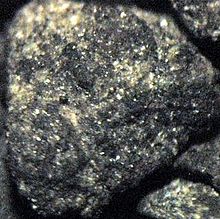- Montney Formation
-
Montney Formation
Stratigraphic range: AnisianType Geological formation Underlies Doig Formation, Fernie Group Overlies Belloy Formation Area 20,000 square feet (1,860 m2)[1] Thickness up to 280 metres (920 ft)[2] Lithology Primary Siltstone and shale Other Dolomitic siltstone, sandstone Location Named for Montney, British Columbia Named by J.H. Armitage, 1962 Coordinates 56°34′18″N 121°13′19″W / 56.57159°N 121.2219°WCoordinates: 56°34′18″N 121°13′19″W / 56.57159°N 121.2219°W Region British Columbia, Alberta Country  Canada
CanadaThe Montney Formation is a stratigraphical unit of Middle Triassic age in the Western Canadian Sedimentary Basin in British Columbia and Alberta.
It takes the name from the hamlet of Montney and was first described in Texaco's Buick Creek No. 7 well by J.H. Armitage in 1962.[3] The well was drilled 41 kilometers (25 mi) north of Fort St. John, immediately east of the Alaska Highway.
Contents
Lithology
The formation is composed of siltstone and dark grey shale, with dolomitic siltstone in the base and fine grained sandstone towards the top.[2] The facies is shaley in the north and west of the extent (Fort St. John), silty in the center (Dawson Creek and Pouce Coupe areas) and becomes coarser (sandy) in western Alberta (Valleyview area).[4]
Oil and gas production
Gas is produced from the Montney Formation in the Peace River Country in British Columbia and Alberta, and oil is produced from the formation in northern Alberta.[4] Horizontal drilling and extensive fracturing process is necessary to flow the low permeability siltstone.[1] Shale gas extraction emerged in the late 2000's in the distal facies of the formation's western extent.
Distribution
The Montney Formation reaches maximum thickness in the foothills of the northern Canadian Rockies at 280 meters (920 ft), and thins out towards the north up to the Fort Nelson area and towards the east to Peace River.
Relationship to other units
Montney Formation is unconformably overlain by Jurassic or Cretaceous beds such as the Doig Formation or Fernie Group and unconformably underlain by the Permian or Carboniferous strata such as the Belloy Formation.
References
- ^ a b Energy TV. "Marvelous Montney". http://www.freevi.com/shows/1/Energy%20TV/4397/Marvelous%20Montney#ajax#shows#from#10#show_id#1. Retrieved 2009-02-07.[dead link]
- ^ a b Lexicon of Canadian Geologic Units. "Montney Formation". http://cgkn1.cgkn.net/weblex/weblex_litho_detail_e.pl?00053:010064. Retrieved 2009-02-07.
- ^ Armitage, 1962; ASPG
- ^ a b "The Montney Play". http://chinookconsulting.ca/News/Montney.html. Retrieved 2009-05-21.
Western Canadian Sedimentary Basin Hydrocarbon history Depositional Regions Southern Alberta · Central Alberta · Northwestern Alberta Plains · South-central Canadian Rockies foothills · North-east Plains · North-central foothills · Liard River · Fort Nelson · Northern Rocky Mountains · Fort St. John · Saskatchewan · Western ManitobaNorthwest Plains Paskapoo FM · Scollard FM · Wapiti GRP · Smoky GRP (Puskwaskau FM · Badheart FM · Muskiki FM · Cardium FM · Kaskapau FM · Pouce Coupe MBR · Doe Creek MBR) · Dunvegan FM · Fort St. John GRP (Shaftesbury FM · Peace River FM · Spirit River FM) · Bullhead GRP (Bluesky FM · Gething FM · Cadomin FM) · Nikanassin FM · Fernie GRP (Rock Creek MBR · Poker Chip Shale · Nordegg MBR) · Schooler Creek GRP (Baldonnel FM · Charlie Lake FM · Halfway FM) · Doig FM · Montney FM · Belloy FM · Stoddart GRP (Taylor Flat FM · Kiskatinaw FM · Golata FM) · Rundle GRP (Debolt FM · Shunda FM · Pekisko FM) · Banff FM · Exshaw FM · Wabamun FM · Trout River FM · Kakisa FM · Redknife FM (Jean Marie MBR) · Woodbend GRP (Irteton FM · Fort Simpson FM · Leduc FM) · Beaverhill Lake GRP (Waterways FM · Swan Hills FM · Fort Vermilion FM) · Elk Point GRP (Watt Mountain FM · Gillwood MBR · Presqu’ile FM · Sulphur Point FM · Pine Point FM · Muskeg FM · Zama MBR · Black Shale · Keg River FM · Rainbow MBR · Chinchaga FM · Cold Lake FM · Ernestina FM · Basal Red Beds · Granite Wash) · Canadian ShieldShale gas · Shale gas by country Geological formations Alum · Antrim · Barnett · Conasauga · Haynesville · Horn River · Marcellus · Montney · Muskwa · New Albany · UticaCategories:- Stratigraphy of Alberta
- Stratigraphy of British Columbia
Wikimedia Foundation. 2010.

